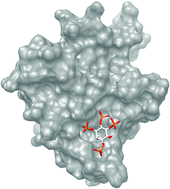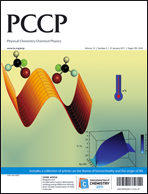A theoretical investigation of inositol 1,3,4,5-tetrakisphosphate†
Abstract
This paper describes the parameterization of inositol 1,3,4,5-tetrakisphosphate [Ins(1,3,4,5)P4] for use in molecular dynamics (MD) simulations. For this theoretical investigation, eleven isomers of Ins(1,3,4,5)P4, with different levels and arrangements of protonation, have been considered. Herein we report accurate quantum mechanics (QM) calculations offering a detailed description of the energetic and structural properties of the Ins(1,3,4,5)P4 isomers and subsequent development of parameters for these isomers for application in the AMBER force field. QM calculations were employed to geometry optimize the Ins(1,3,4,5)P4 isomers, using the DFT-B3LYP level of theory in gas phase. In subsequent steps, charge parameters were generated for each isomer. These charge parameters, plus assigned atom-types from the AMBER ff99SB force field, were then applied to the optimized isomers for energy minimization in AMBER. The quality of the parameters was evaluated by comparing the structural, energetic and spectroscopic properties of the Ins(1,3,4,5)P4 isomers between the QM geometry optimization stage, from which the parameters were generated, and the energy minimization stage, in which the parameters were applied. The results were shown to be in strong qualitative agreement between these stages, suggesting good quality parameters have been obtained. Additionally, adaptations to the gas phase protocol, investigating the use of the MP2 method for the geometry optimization stage and GAFF atom-types for the energy minimization stage, were tested. These results confirmed the initial protocol applied was the most appropriate. Calculations for the Ins(1,3,4,5)P4 isomers were also carried out in the presence of implicit


 Please wait while we load your content...
Please wait while we load your content...